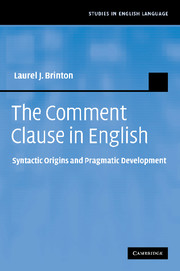Book contents
- Frontmatter
- Contents
- List of figures
- List of tables
- Acknowledgments
- List of abbreviations
- 1 Introduction: comment clauses, parentheticals, and pragmatic markers
- 2 Semantic and syntactic development of pragmatic markers
- 3 Processes of change
- 4 Comment clauses with say
- 5 I mean
- 6 Comment clauses with see
- 7 If you will and as it were
- 8 Comment clauses with look
- 9 What's more and what else
- 10 Epistemic/evidential parentheticals – I gather and I find
- 11 Concluding remarks
- References
- Author index
- Subject index
10 - Epistemic/evidential parentheticals – I gather and I find
Published online by Cambridge University Press: 12 July 2009
- Frontmatter
- Contents
- List of figures
- List of tables
- Acknowledgments
- List of abbreviations
- 1 Introduction: comment clauses, parentheticals, and pragmatic markers
- 2 Semantic and syntactic development of pragmatic markers
- 3 Processes of change
- 4 Comment clauses with say
- 5 I mean
- 6 Comment clauses with see
- 7 If you will and as it were
- 8 Comment clauses with look
- 9 What's more and what else
- 10 Epistemic/evidential parentheticals – I gather and I find
- 11 Concluding remarks
- References
- Author index
- Subject index
Summary
Introduction
To date, most work on comment clauses has focused on first-person parentheticals, the so-called “epistemic parentheticals” such as I think and I guess. Detailed synchronic studies of I (don't) think (see Thompson and Mulac 1991b; Persson 1993; Stenström 1995; Aijmer 1997; Simon-Vandenbergen 2000; Kärkkäinen 2003), I don't know > I dunno (Tsui 1991; Scheibman 2000; Diani 2004), you know > y'know (Goldberg 1980; Markkanan 1985; Erman 1987; 2001; Schiffrin 1987; Crystal 1988; Stenström 1995; Fox Tree and Schrock 2002), I guess (Thompson and Mulac 1991b; Van Bogaert 2006; Kärkkäinen 2007), I suppose/I believe (Van Bogaert 2006) as well as you see (see §6.2.1.2) and I mean (see §5.2) have established a variety of pragmatic functions for these comment clauses, such as hedging, politeness, or discourse-organization. Despite their designation as “epistemic,” they have been shown to express authoritativeness/conviction as well as uncertainty/tentativeness (see Aijmer 1997 on the “tentative” and “deliberative” uses of I think).
Diachronic studies, while less numerous, have examined I think (methinks), I'm afraid, I'm sorry, I pray you/thee (> pray), and I promise you (see §2.3.3.1 and §3.2.3.2 for reviews of these studies). Most recently, Wierzbicka (2006) has argued that epistemic parentheticals arise in the first half of the eighteenth century and are causally related to the rise of English Empiricism, which emphasized the limitations of human understanding and led to the need to specify the epistemic status of utterances.
- Type
- Chapter
- Information
- The Comment Clause in EnglishSyntactic Origins and Pragmatic Development, pp. 219 - 239Publisher: Cambridge University PressPrint publication year: 2008



